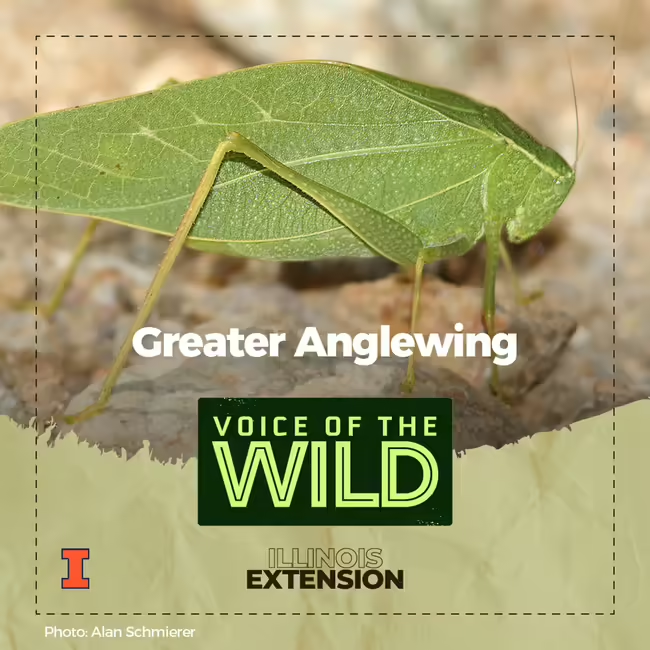
Episode Number
24
Episode Show Notes / Description
Greater Anglewing, (Microcentrum rhombifolium).
Appropriately named, the greater anglewing has curiously rhombus-shaped wingcovers. These clicking insects emerge a few weeks after the common true katydids and add a strange stone-tapping sound to the grinding chorus of other night singers.
Thank you to Wil Hershberger for letting us use the insect calls from SongsofInsects.com.
Do you want to learn more bird songs, frog calls, and insect noises? Join Voice of the Wild every Friday to explore a new wild voice. We’re available on most podcast platforms, including Apple Podcasts, Spotify, and YouTube.
Subscription links Here
Subscribe to the Newsletter
Sources and more:
- http://songsofinsects.com/katydids/greater-anglewing
- https://bugguide.net/node/view/6891
- Guide to night singing insects of the northeast by John Himmelman
Transcript
This is Illinois Extension’s Voice of the Wild. a new wild voice in just a moment, so find someplace quiet, take a deep breath, and enjoy.
A few weeks after the common true katydids begin grinding out their evening chorus, they’re joined in the treetops by a tick-ticking complement. This clicking companion is another master of disguise; its wingcovers, like those of other katydids, are leaf green with striking leaflike venation. But unlike most other katydids, those wingcovers are also curiously angular.
This is the Greater Anglewing, Microcentrum rhombifolium, from the katydid family Tettigoniidae. This family of insects is in the same order as the grasshoppers; orthoptera. Here’s the Greater Anglewing calling again. Listen for the two kinds of songs; one is the unsteady ticking that sounds a little like tapping stones together while the other is the sturdy, flat “dzip.”
Thank you to Wil Hershberger for letting us use the insect calls from SongsofInsects.com. You can find a link to that website in the description. And thank you for tuning in to learn a new wild voice with Illinois Extension.
When I was younger I wrote a poem about night singing insects. I wrote it before I knew much about the natural world, I just knew that I liked the sound of the summer night. I think about it every year around this time, as the cold nights start slowing all those night singers down. I’m glad I fell in love all those years ago, as it led me to where I am today. I’m going to read it now.
Goodbye to the noisemakers:
Those twilight belters and Moonrise greeters
Those ridge-plucking stridulators
And dusk-loving long-jumpers
To the last of those midnight lovers:
The slow-ticking leaf shakers,
sluggish chippers, and rasping last-chancers;
I’ll miss you, noisemakers.
You were summertime’s keeper
But the year goes and the frost hovers.
Till next summer, noisemakers,
One last good night.
A few weeks after the common true katydids begin grinding out their evening chorus, they’re joined in the treetops by a tick-ticking complement. This clicking companion is another master of disguise; its wingcovers, like those of other katydids, are leaf green with striking leaflike venation. But unlike most other katydids, those wingcovers are also curiously angular.
This is the Greater Anglewing, Microcentrum rhombifolium, from the katydid family Tettigoniidae. This family of insects is in the same order as the grasshoppers; orthoptera. Here’s the Greater Anglewing calling again. Listen for the two kinds of songs; one is the unsteady ticking that sounds a little like tapping stones together while the other is the sturdy, flat “dzip.”
Thank you to Wil Hershberger for letting us use the insect calls from SongsofInsects.com. You can find a link to that website in the description. And thank you for tuning in to learn a new wild voice with Illinois Extension.
When I was younger I wrote a poem about night singing insects. I wrote it before I knew much about the natural world, I just knew that I liked the sound of the summer night. I think about it every year around this time, as the cold nights start slowing all those night singers down. I’m glad I fell in love all those years ago, as it led me to where I am today. I’m going to read it now.
Goodbye to the noisemakers:
Those twilight belters and Moonrise greeters
Those ridge-plucking stridulators
And dusk-loving long-jumpers
To the last of those midnight lovers:
The slow-ticking leaf shakers,
sluggish chippers, and rasping last-chancers;
I’ll miss you, noisemakers.
You were summertime’s keeper
But the year goes and the frost hovers.
Till next summer, noisemakers,
One last good night.